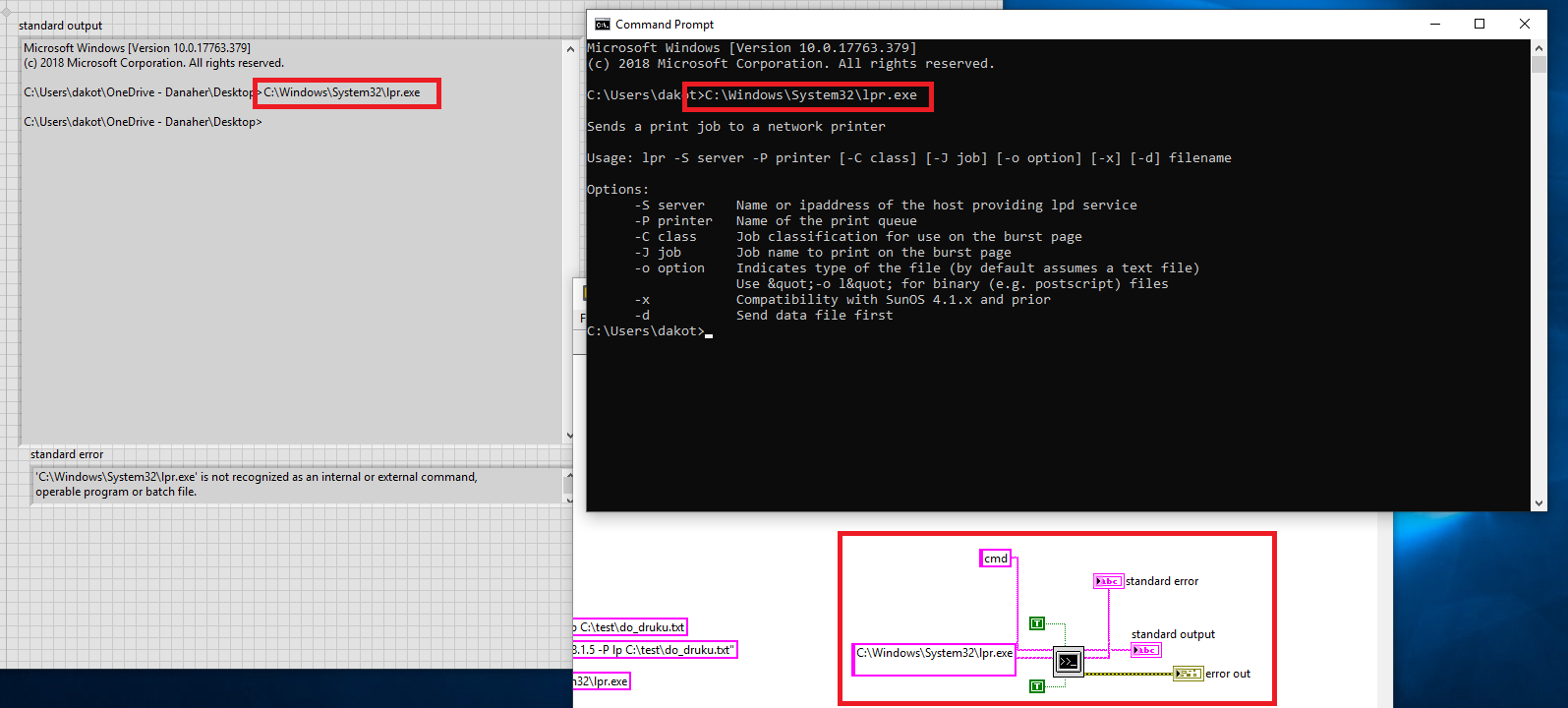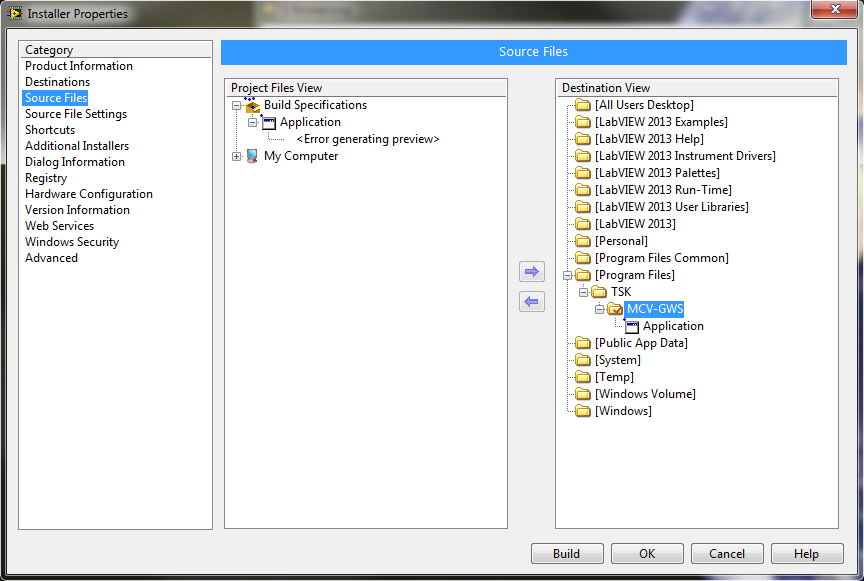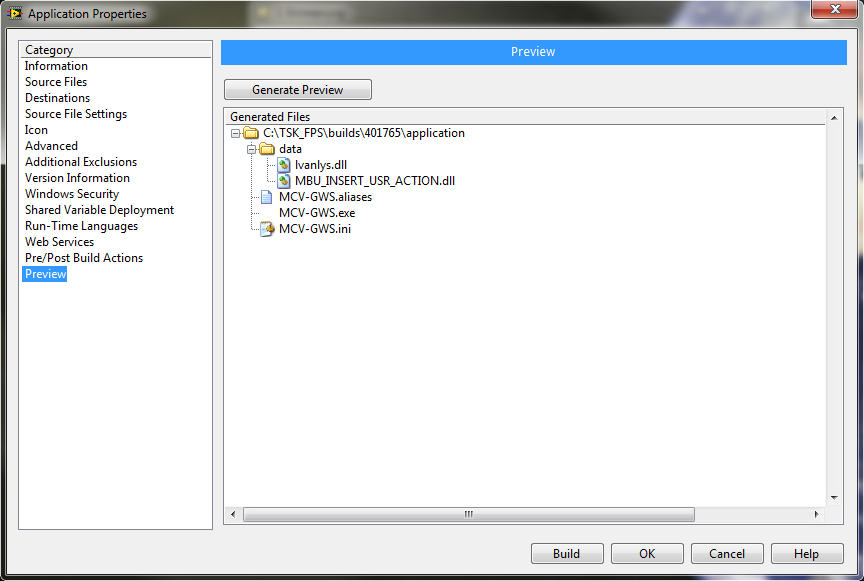Search the Community
Showing results for tags 'application'.
-
We have a gage supplied by a company that shipped it with a *.exe application targeted for LVRTE 2009. I need to retarget it for 2017, but don't have the source code. The supplier had said they'd gladly supply me with a copy of the *.LV source, but they have looked and cannot find their own copy in-house. History of Need: Our global corporate mother ship's IT department, in their infinite wisdom, is mandating an upgrade from Win7 to Win10. That with yet even further constraints. They enforce a list of "approved versions" of "approved applications". And for LVRTE, they are insisting upon 2017, with 2009 being a red light. So, then, my query. Is converting an app without the source for a higher LVRTE doable at all? File is attached. If it is doable, instructions on how? Concentricity-Gage.exe
-
I'm trying to execute LPR.exe command to print some labels on a printer. However as its normal, problems occur. I could not find answer on any topic conneced with "sytem exec". I already tried all described methods (I think so). That's why I'm asking very kindly for any help. When trying to execute or call the LPR.exe from System exec VI, I'm receiving error: "'C:\Windows\System32\lpr.exe' is not recognized as an internal or external command, operable program or batch file." Generally I would like to call function: "lpr -S 192.168.1.5 -P lp C:\test\do_druku.txt" which works from command window without any problem. print.vi
- 11 replies
-
- application
- executable
-
(and 1 more)
Tagged with:
-
Hello Labview Users, I happen to have thousands of csv data file that I work with. The only way I recognize them is putting their characteristics in the file name. Which brings the problem of making the names too long and Microsoft doesn't like to accept long name. So I wanted to build a database for all my files. I am in the preliminary stage of building it ( I have attached the file and some of you may have seen it before). What I want to do is, have all my files in the database with random names and list them based on their characteristics. I want to do that in my application in the place of 'file' box. So that I can click on the file and run it (double-click on the file in application to make them work in active file). based on the parameters listed on the database I want to filter them to find any specific file. How the interface of database should look like is shown blow (Image) . It doesn't have to be a real database, just a directory application. I am trying to make it without the database toolkit. If anyone can help me out and guide me out or guide me in the right direction then that would be great. Thanks. Multicolumn list box v1.5.vi
-
Hi! I am looking for a Senior Software Developer to work on our LabVIEW based sensors and applications. I am also looking for Senior Software Developer(s) available for contracts (somewhat local to London) . Please note that this is about product development in LabVIEW (as opposed to test development). More info here: https://silixa.com/about-us/careers/
-
- developement
- application
-
(and 2 more)
Tagged with:
-
Hello to all. I have a 32 bit application created with application builder 32 bits Labview 2015 SP1. It runs in 64 bits OS but sometime it is slow. So I think that one solution could be to create a 64 bits application. is it going to improve from 32 bits to 64 bits? I am using Vision adquisition software toolkit and its run-time vision. Thanks a lot.
- 8 replies
-
- application
- 64 bits
-
(and 1 more)
Tagged with:
-
Hi LAVA, I need your help! I've recently started updating a system from LV8.6 to 2011SP1, and have ended up in confusion. I deploy the system as executables on two different machines running Linux Ubuntu, one a laptop with a single processor and the other a panel PC with two processors. What happens is the on the first, single-processor computer I see a dramatic fall in the use of the CPU. The other in contrast shows a dramatic raise in CPU usage. The computers do not have LV installed, only the RTE:s. Machine1 (1* Intel® Celeron® CPU 900 @ 2.20GHz): CPU% with LV8.6: 63% CPU% with 2011SP1: 39% Machine2 (2* Genuine Intel® CPU N270 @ 1.60GHz): CPU% with LV8.6: 40% CPU% with 2011SP1: 102% In the second machine the max CPU is 200% since it has two CPU:s. The load seems to be pretty even between the CPU:s. Why is this happening, and what should I do to get the CPU usage down on machine2 (the one being shipped to customers)? /Martin
- 12 replies
-
- linux
- application
-
(and 3 more)
Tagged with:
-
Hello everyone, I recently installed LabVIEW 2013 on my development machine to get rid of some issues in my current project. However the project is originally build in LabVIEW 2011, so I had to save all VIs for the new version (no issues ) I'm still able to build the application executable with no problems too! Now I want to provide an installer for the customer to upgrade the Runtime engine and some additional stuff that has been changed for LabVIEW 2013. And there lies my problem, as I'm currently unable to build an installer. The configuration dialog shows 'error generating preview' for any executable in the project: Naturally I tried to generate the preview in the executable, but there seems to be no issue: Creating new specifications did not solve the problem and even creating a whole new project file and including the startup VI to it + creating new specifications did not solve the problem... I made a new project with a single VI for testing if the application builder is not working in general, but thats not the case, as I was able to create an application + installer with no issues. So I'm quite sure there is something wrong in my project that causes this behaviour, but I've currently no clue what that could possibly be. I read somewhere (in the NI forums I guess) that there could be issues if you have files in your project that are build in an older version (as one of the dll files), so I upgraded it... with no success... Now does anybody had an issue like that in the past / currently and is there anything I could do or check to regain the ability to provide a proper installer? What could possibly cause the installer dialog to fail generate a preview where the application dialog is successfull? Any ideas are welcome
- 21 replies
-
- error
- generating
-
(and 3 more)
Tagged with:
-
Is there an easy way to get the destination directory the user selects during custom executable installation? There are probably some ways to get it using a post installation application, but it seems like a cludge. Ideally what I'd like to do is create a registry entry during installation that records the installation directory.
- 2 replies
-
- application
- installer
-
(and 1 more)
Tagged with:
-
Hi all, Does anyone know if you can run Labview on the Gumstix which is Linux based (Tiny USB stick sized Linux computer)? https://www.gumstix.com/ Cheers P Each DuoVero™ COM comes standard with: Processor: Texas Instruments OMAP4430 Dual Cortex™-A9 Speed: Dual-core, up to 1GHz Memory: 512MB or 1GB RAM On-board: microSD slot Dimensions: 58mm x 17mm x 4.2mm Add features with DuoVero® expansion boards
- 8 replies
-
- linux
- application
-
(and 1 more)
Tagged with:
-
I am designing a method for multiple application instances to coordinate an action across a network. I have previously implemented this using queues for coordination of asynchronous VIs within a single application instance. I now need to make this work across a local network. I have been looking at network shared variables, network streams, TCP/IP, UDP. I would like to know if anyone else has accomplished this and what you learned along the way. The basic requirements are: N number of independent applications need to coordinate some action (essentially a rendezvous). No one application knows if the others exist. (don't know their IP or anything about them) No one application knows if it will be the first to join or will join later. All applications will share a common name for the rendezvous. The first application should create the rendezvous As other join, they should see that the rendezvous already exists and join it instead of creating a new one. All applications should be able to see how many have joined. When all applications depart, the rendezvous should be destroyed by the last one to leave. Thanks for any tips or examples you can share. -John
-
I know there is the windows message queue API that can be downloaded, and I have this working fine and am receiving messages. But unfortunately this requires polling the message queue in my application. I'd like to handle these messages as events in an event structure, and I can do that by having a polling loop to manage the message queue, which then fires a user event when the correct message is captured from windows. But, is there a way to do this any cleaner, similar to being able to register events based on callbacks?
- 21 replies
-
- design
- application
-
(and 3 more)
Tagged with:
-
Just for the sake of my own curiosity, I was wondering if anyone knew what is "wrapped" in the NI builder in order to create installers? Is the .NET Installer class being used to create installers, or something else? I was also wondering if there is something like the OpenG MSI Installer Builder that can be used with newer versions of LabVIEW? It seems it can't be used after LV7.1. I really like the idea of being able to customize my installers to look a little less plain during installation. If not, I wouldn't mind throwing my own together if someone could point me in the right direction. Or, even if one does exist, I wouldn't mind writing my own for the sake of learning. Thanks.
- 5 replies
-
- application
- builder
-
(and 1 more)
Tagged with:
-
Hi all, My question deals with how best to distribute large collections of lvclasses that implement a 'plugin' architecture. Some background first: I've been reading the lava forum for about two years and dove head first into LVOOP about a year and a half ago. As such I may be calling what I have 'plugin' when a better term already exisits for what I'm doing; please correct me if there is a better term. The application I've got implements essentially a dynamic form that allows the user to structure properties of a tdms file with information needed to complete some kind of test on one of our products. This 'blank' file is distributed to the correct test stand where it can be used to spawn data files that are populated with information from each test run. Pretty common task I think. To implement this I have a four-tiered class hierarchy: Generic Metadata -> Generic Product Series -> Specific Series -> Specific Model The bulk of the code and all the interfaces are implemented in the first two classes with the last two providing overriding methods as needed for whatever specific product is being worked with (which is why I'm calling it a plugin architecture). This means the last two classes represent an ontology of the company's product line, which means there are a LOT of classes there. Last count I had 24 Specific Series and around 1000 Specific Models. In the development environment, I load the first two classes as constants on the block diagram then use a factory to load the specific classes from disk at run time by building a relative path off of the top level class path. This works well because all the classes are part of my project and are therefore easy to manage on disk, but I need to be able to build this application into an executable and distribute it to the entire company. How can I include the classes in my distribution and load them at run time without making maintenance a nightmare? Would packing each class and its methods into an llb, including all the llbs in an installer, and loading each class from the llb at run time work? Would my dynamic VIs work from inside llbs? Would packed project libraries be a better choice? Do I have to put the entire class hierarchy inside the library or can I compile the top two classes into the exe? Lots of questions! Also I tried to upload a diagram of my class hierarchy, but I think my webfilter is preventing me from uploading anything.
-
UPDATE : THIS SUPPORT APPLICATION ENGINEERING POSITION IS BASED ONLY IN ATLANTA Averna at a glance: Averna delivers industry-leading test solutions and services for communications and electronics device makers worldwide, accelerating product development, quality and innovation. Be global@work: Serve international customers and collaborate with colleagues in Canada, the U.S., Mexico, Japan and Hungary. Drive innovation@work: Participate in the development of market-leading high-tech products in the telecom, transportation, electronics and multimedia sectors. Develop your talent@work: Contribute to thrilling projects that will stretch your skills and talent to the maximum. Enjoy success@work: Be part of a fast-growing company with award-winning products and team. Share your passion@work: Meet passionate people, enjoy our modern environment and dynamic atmosphere. The challenge of the Support Application Engineering position: The Support Application Engineering position is responsible for customer technical support and some development activities. The chosen candidate will: Develop a deep and broad understanding of Averna tools and products; Use the in-house tools to track customer requests; Take ownership of problems and see them through to successful resolution; Be called to travel about 30% to 50 % of the time. Duties and responsibilities: Provide primarily first and second tier remote customer support, troubleshooting and solutions for existing customers; Diagnose, De-Bug and fix less complicated bugs using but not limited to LabVIEW, TestStand, C, C++, and/or VHDL; Work with senior developers to identify and resolve complicated technical software problems, and some hardware problems; Become an Expert User for the Jupiter and Mercury Platform; Involved in developing new features and tools; Document frequent issues into scripted processes; create FAQ; Document required bug fixes, end-user feature improvements, and operations feature improvements; Troubleshoot problems and solve the incidents through a methodical and process based approach; Reproduce errors reported by clients and escalate to R&D by providing a narrowed down list of possible causes; Analyze recurring problems and suggest improvements to Peers in the R&D and Services teams Provide thorough root cause analysis to Customers; Document troubleshooting flowcharts based on real life scenarios; Commit and contribute to a high level customer satisfaction by providing best in class Support and Service; Occasional week night or weekend work is required to support customer from different time zones and with urgent requests (approx. 15% of the time). Qualifications: Bachelor degree in computer science, electrical engineering or computer engineering; 2-5 years experience solving deployment and support issues is an asset; Experience with RF is required; DOCSIS experience is a strong asset; Good general computer knowledge (e.g. Windows, TCP/IP networking, FTP) with a strong aptitude for problem solving; Experience in software engineering for test platforms or real-time software engineering; Able to read engineering design documentation (mechanical, electrical or software); Knowledge of broadband and telecommunication industries is an asset; Practical experience with LabVIEW, TestStand, TCL programming is an asset; Practical experience with MS SQL and MySQL is an asset. Comportments/ Behavior Ability to quickly learn systems and trouble shoot with the customer live and remotely; Pro-activity, autonomy, self motivated individual; Likes to interact directly with customers to achieve customer satisfaction with a "can do" attitude, ability to easily establish good relationships with customers; Diplomacy, open-mindedness, and patience, great listening; Good verbal skills for telephonic work and ability to develop well written documentation; Excellent oral and written English communication skills. Chinese Mandarin skills are an asset. Please send your resume to cv@averna.com and mention the title of the position: Support Application Engineering position We thank you for your interest towards Averna. Please note that only those candidates being considered for the position will be contacted.
-
- support
- application
-
(and 3 more)
Tagged with:












